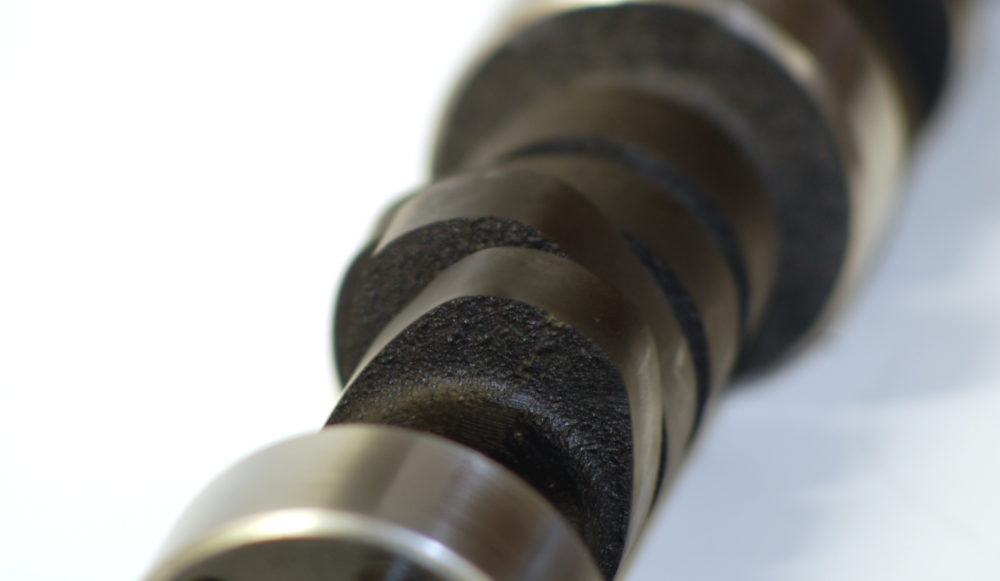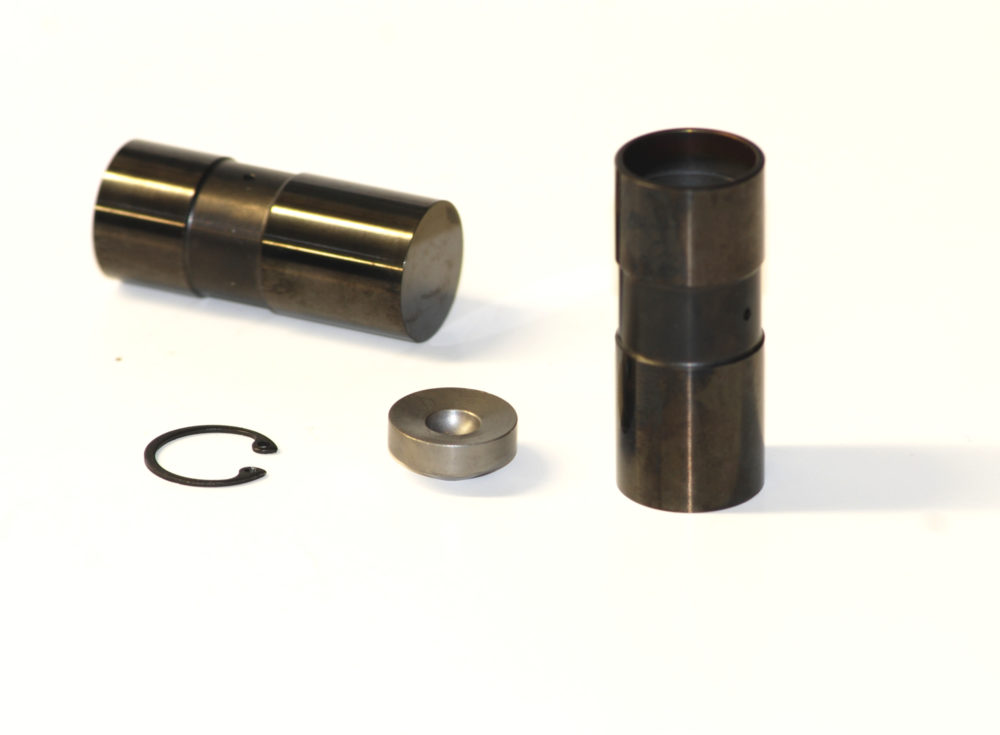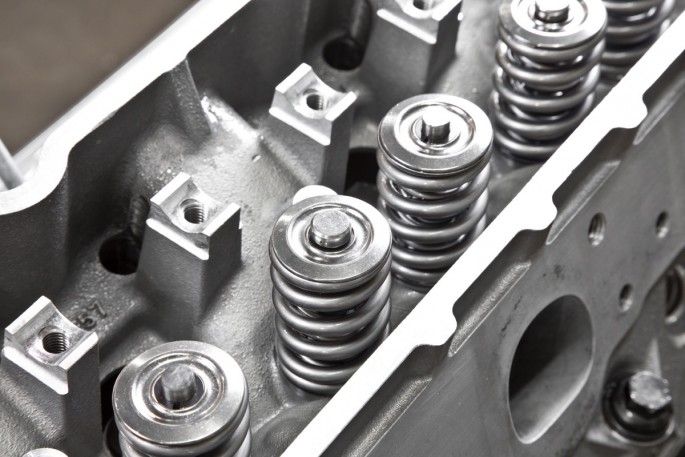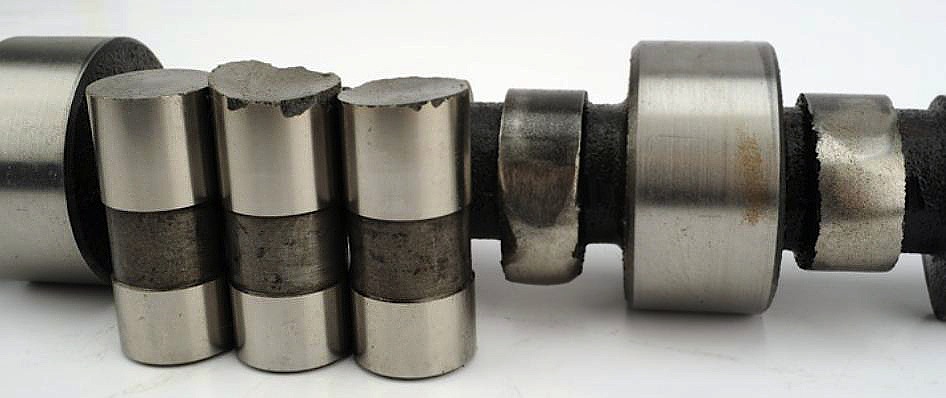
Camshafts and lifters are available in two basic formats—roller and flat tappet. And then within those two formats, they can either be of the mechanical (solid), or hydraulic variety. Fair enough. That should come as no surprise to most people reading this.
But what makes up a flat tappet lifter?
They’re typically hollow steel and incorporate a steel pushrod-operating cup. The cup is fastened via a steel-retaining ring. Some lifter types incorporate an oil-metering valve to control the oil feed to the pushrods. Hydraulic lifters incorporate a self-adjusting mechanism. Here, pressurized oil flows into the lifter through one opening and enters the hollow body of the plunger through another. Solid lifters don’t have this mechanism and as a result, lash clearance is set at the valve tip. Hydraulic lifters mandate preload (which is basically distance between the retaining snap ring and the plunger seat when the valve is closed). Once you set hydraulic lifters, no further maintenance is needed (which most of you already know).
While operating, any flat tappet is allowed to rotate in the bore as it moves up and down. To get there, the cam lobe is tapered slightly. Ditto with the camshaft contact face of the lifter (it’s slightly crowned and not exactly “flat”). The rotation of the tappet within the bore evens out the wear of the lifter (particularly at the edge where it comes in contact with the camshaft lobe).
Isn’t a Flat Tappet Lifter an Obsolete Commodity?

Roller lifters for pushrod engines and overhead camshaft configurations are today’s norm. There isn’t a car built today that comes with a flat tappet cam.
Again, no surprise, but wait: There are plenty of places where flat tappets still see considerable use (some by racing rules). Up until a few years ago, NASCAR mandated flat tappet cams on their Cup Cars.
In NHRA Stock Eliminator, there are still plenty of good old-fashioned flat tappets in use. The rulebook stipulates what lifters can and can’t be used. Plenty of Stockers came with either solids or hydraulics of the flat tappet kind. The reality is, the same applies to countless hot rods, vintage muscle cars and street machines. Flat tappets are still around and more common than many might think.
Because of that, there’s some trickle-down technology, but some of it doesn’t really help the little guy. For example, those recently obsoleted Cup car cams cost upward of $2,000. A set of tool steel lifters for that Cup car camshaft can run from $600 to $3,000 for the set, depending upon how trick they really are. That’s probably cheap for a Cup Team, but for folks like you or me, that can be prohibitively expensive.
Has Any of that Technology Trickled Down to Our Level?
While the cam manufacturers all agree that Cup car technology (even older tech) is pretty much in outer space, there are some tech developments you can use.
One example is the EDM hole in the base of some lifters. Electrical Discharge Machining provides a tiny orifice for adding lubrication between the lobe and lifter face.
Not all cam companies agree on the value of the machining EDM holes, but some manufacturers believe there’s a reliability advantage when using lifters with EDM holes.
There are actually two different EDM arrangements available—one centered in the lifter base and another where the hole is offset. As the lifter spins, the offset hole will lose contact with the cam lobe. Some engine builders have a preference for the offset hole while others prefer the on-center EDM hole.
Another innovation from racing flat tappets is the actual finish on a camshaft. Parco Lubrite or “Parkerizing” has been the standard for final surface treatment on cast iron cams for what seems like forever. Lubrite is a Manganese Phosphate Conversion Coating, which is formulated to produce non-metallic, oil-absorptive coatings on iron and steel bearing surfaces. These corrosion-resistant coatings consist chiefly of iron and manganese phosphates, and are engineered to reduce wear on camshaft lobes and tappets, as well as other bearing surfaces. In today’s marketplace, some cam manufacturers are micro-finishing cam journals and lifters. Micro-finishing provides a fine, almost polished, surface for the cam and lifter contact points.
Another option includes nitrided surface treatments for flat tappet camshafts. With this process, the cam is heat-treated which case-hardens the cam core.
And yet another tech development is Diamond-Like Carbon, or DLC, which involves very hard, man-made coatings being bonded to the surface of something like a lifter face to harden the surface properties. Surfaces with DLC coatings tend to be extremely slick and wear-resistant. NASCAR teams used DLC-coated lifters with steel-core camshafts. All of these technologies are available for use on flat tappet cams—and in some cases, lifters—but some of these processes and are cost-prohibitive for many of us individuals.
New Lifter Tech Bred Cam Profile Changes
With this new lifter technology, cam profiles changed. Camshaft grinders note that the gains have been incremental. Only a small part of those gains are a result of new lifter technology.
Flat tappet cams once considered state-of-the-art, are no longer. What we see today are cams with more radical opening and closing rates—more like the square-nose cams developed years ago for NHRA Stock Eliminator racers. What these profiles did was place more area under the curve, which improves cylinder filling and exhaust pumping.
It’s not the lifter that’s responsible for the successful use of these “square nose” camshafts. It’s the valve spring along with the rest of the valvetrain. For decades, the standard for a small block Chevy pushrod was a 5/16-inch diameter job. It was deemed sufficient for almost any cam you could stuff in the engine. In today’s world, most pro engine builders will advise you to use the biggest (diameter-wise) and stiffest pushrod you can get away with. As a result, there’s been a big move toward large-diameter, ellipsoidal or tapered pushrods. Here, pushrod column strength is the key.
Advancing Spring Technology

Spring technology for flat tappet camshafts has improved. The beehive-style spring is a good example. Here, the oval/multi-arc wire shape places the maximum area of the wire at the point of highest stress to handle valvetrain stress more efficiently, and gets better heat dissipation for longer life. Because of the unique beehive configuration, the valvetrain can handle more rpm and more-aggressive cam profiles. Beehive-style valve springs provide a double weight savings in your valvetrain by reducing weight of the actual spring and allowing a smaller, lighter retainer. We’re barely scratching the surface here, but as you can see, there’s plenty of modern tech available to breathe new life into an old engine combo.
Other Things to Consider with Flat Tappets
There’s more to consider with the use of flat tappets.
Flat tappets will certainly limit the spring pressure you can use safely (particularly in comparison to a solid roller). Spring rates for flat tappets vary by application. For example, the seat pressure on a hydraulic grind will be less than 135 pounds with an open pressure of 350 pounds maximum. A solid, on the other hand, can have a seat pressure less than 160 pounds, and an open pressure of 385 pounds. Compare those to an older NASCAR Cup cam combination with tool steel components: They have open pressures of 450 pounds and 220 on the valve seat. Which is a lot.
Lifter-to-bore tolerances and overall geometry are critical, particularly when you consider that many of the engines using flat tappet lifters are decades old (Case in point: The small block Chevy 265 has long passed its 60th birthday).
Another issue people run into is core shift. Some engines are plagued by the problem more than others, but it’s not out of reason to sleeve a set of lifter bores to fix both wear, past damage and geometry issues. When lifter bore sleeves are installed, the machine shop sets the block up in a fixture, which in turn determines the angle of the reaming tool. Once the bores have been aligned and opened (oversize), sleeves (most often bronze) are pressed into place. The sleeves are then trimmed and beveled before they’re finish-honed to size.
This way, the lifter bores can be blueprinted—providing proper lifter-to-bore clearance along with correct geometry. I should point out that if the geometry is spot on, the bores look good, and the lifter-to-bore clearance is good, then all the bores require is a quick touch with a lifter-honing tool. Here, the idea is to create a smooth, crosshatched finish. Each machine shop will have its own concepts of how smooth the crosshatch will be. Please keep that in mind.
Camshaft Performance Rankings
Aside from cost and regulations, probably not.
But there isn’t a huge difference in internal-friction reduction by switching to a roller—maybe 5 horsepower at best. In fact, a flat tappet solid cam, in many cases, actually out-power a hydraulic roller. The cam manufacturers point out that a hydraulic roller is a rather hefty component. Add oil weight to the total and you can see why it can be out-performed by a solid.
From a style-standpoint, you can pretty much rank camshaft performance this way:
1. Solid Roller
2. Solid Flat Tappet
3. Hydraulic Roller
4. Hydraulic Flat Tappet
Loft is Something Else to Consider
Loft is where the engine actually sees more lift than the cam provides. It’s like controlled valve float. It occurs in many flat tappet NHRA Stock Eliminator engine combinations. It increases both lift and duration. In practice, it’s possible to hit a flat tappet cam hard to achieve loft—particularly in the case of a solid. It’s also possible to achieve loft with a hydraulic, but here, some of the short travel (small preload) hydraulic race lifters are the key. Bottom line: Loft is good for power, if you can control it.
Don’t Forget About Motor Oil

When working with a flat tappet combo, and keeping it running, oil is key. And not just the oil, but the additives contained in the oil.
As automakers moved away from flat tappets, the major oil companies fell in line with their additive packages. One of the early additive packages that went away included a compound called Zinc Dialkyl Dithio Phosphate, or ZDDP.
Zinc-based additives include anti-wear/anti-oxidant properties. It’s ideal for engines—particularly those fitted with flat tappet cams. ZDDP was a standard additive in motor oil well into the 1990s.
There was an issue with ZDDP—the phosphorous found in the additive doesn’t agree with catalytic converters. Because of that, and coupled with the move to roller camshafts, ZDDP got caught in the crosshairs.
Unfortunately, there wasn’t much thought given to the tens of thousands of vehicles on the road, or in garages, with flat tappet camshafts.
Because no one told the aftermarket cam manufacturers that the additive packages were modified. When ZDDP quietly went away, engine havoc ensued. Cam manufacturers took the brunt of the hit even though they didn’t deserve it.
Fortunately, a few oil companies were paying attention. Several now offer quality oils with comprehensive additive packages (including ZDDP) designed for use with flat tappet camshafts. Brad Penn, Joe Gibbs Driven, and Valvoline VR are three quality examples. Additionally, Trick Flow, COMP Cams, Lucas Oil, Red Line, and others, offer ZDDP in additive form you can use to treat today’s off-the-shelf motor oil.

love the story, thanks
Great article. Well written.
I wanted to run a solid roller in my sbc due to the expense of retro hydraulic roller lifters, so I asked a major cam maker for a recommendation. He recommended a particular solid roller with a basic operating range of 4000 rpm-7800 rpm!!!!! For a street engine no less. Ummm, I think I might choose my own solid flat tappet cam with a reasonable operating range since the article implies that it still could survive with the alternative oils.
The roller and flat tappers are two different animals so I don’t think springs are even near the same but if you talk to David Vizard you’ll find that flat tappers are comparable to or possibly even better to 275/470 but as I read these article with people building motors you can tell who’s who what with not matching cams and converters and 700 hp for the street. but flat tappers are not gone by any means.as I started building and I had to for the money so I also started buying books and now have a small library cause it was before cell phones and computers and I like many got caught between gen 1 ANC’s and all the new generation but nothing useable on the each other like all the gen 1’s so you had one or the other and that goes for alum. heads.everyone thinks you have to have them.it’s nice but no and I’ve seen iron beat alum.that where your skill and libraries and computers now come in handy but I don’t get why we have to have stuff that’ll go to the moon when we only need to go to the store.I like the new block and such but for me power is power new or old and none of its cheap
I have a 71 ranchero 429 cj and the problem is bent pushrods. Who makes a good set? I try to not rev past 5500 as I have spent a lot of money on on this motor. Any suggestions?
Hey William, to get the best answer, click here to reach out to the Summit Racing tech folks directly. They’ll ask you some specifics on your 429 and recommend a set of pushrods that’ll fit the bill.